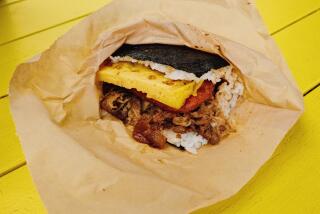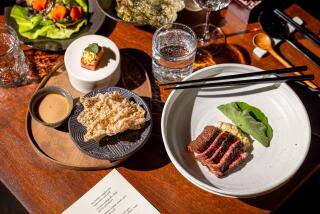He Thinks the World of His Antique Globes
- Share via
At 28, Jonathan Blackman is a man of the world. Or--forgive us--one might even say he thinks globally. Blackman deals in antique globes.
In a small space called Interiors, he sits amid globes large and small--wooden globes, glass globes, even a sort of early motel globe lamp.
Contemporary jazz plays in the background as he explains how he veered off course on his way to law school after getting a degree in political science from Brandeis University.
Maybe, he suggests, he just had to stand out from the crowd: “There are plenty of lawyers.” Maybe he always felt cheated that his New Jersey high school didn’t offer geography.
Some would consider the latter a blessing, but Blackman likes geography. Old globes are rarely dated and he delights in using political geography to trace their age through shifting national borders and evolving country and city names. Istanbul, nee Constantinople. St. Petersburg-Petrograd-Leningrad-St. Petersburg.
The world changes faster than globe makers can make globes, but that doesn’t worry Blackman, who is “not intrigued by anything new.” The beauty and workmanship of the old globes are what hook him. As he points out, a new one is outdated almost before it’s out of the crate.
After stints as a fund-raiser for Carnegie Hall and a sports marketer for ESPN, Blackman, an ex-New Yorker, started in the globe trade by renting stalls in L.A. antiques malls. When his first globes, bought at auction and at flea markets, were snapped up, he “knew there was a niche.”
Last September, he moved into a space on Robertson Boulevard, where he has about 30 globes ranging in age from a 1960s classroom model on a blond wood base to a Dutch-made early 18th-Century wooden globe inscribed in medieval Latin.
That one might be considered prophetic. It depicts California as an island. When Blackman bought it, it had been made into a lamp. His asking price, unwired: $9,500.
As every globe has a cartouche, telling who made it and where, why don’t they all have dates? Theories abound. Some say it’s to force people to learn their history and geography. Or maybe, Blackman says, it’s so “people wouldn’t know when the globe was outdated.” But what kind of planned obsolescence is that?
Blackman’s treasures include an early 19th-Century celestial globe with images of the constellations in the night sky, illuminated glass globes of a type common through the 1950s and a pair of big steel school globes from the ‘20s or ‘30s. Their land masses are not identified; that was up to the students.
Most early globes were of wood, commonly overlaid with gesso and paper. Blackman almost winces at mention of today’s plastic models with their faux wood bases.
In their new book, “Globes From the Western World,” Elly Dekker and Peter van der Krogt tell us the earliest terrestrial globe in existence is in Nuremberg, Germany, where it was made in 1492. It has a big land gap; the Americas were not yet known to Europeans, although they soon would be.
Dutch globe makers were the elite until the Italians came along with ornate globes, some of which had caryatid-like figures holding up the earth. Most globes in American homes were British until Vermont farmer James Wilson started making globes in the early 1800s.
Once, globes were made for cardinals and kings and were out of reach for ordinary folk. Today, they are a chic decorative item--”especially in California,” Blackman observes.
Is this just a designer variation on books-by-the-yard, or. . . ?
Well, he suggests, perhaps people use them to plan their travels. Or maybe they’re hooked on “Jeopardy!”
Gourmet Spam Cooks Reveal Artistic Flair
Sing along, now:
“Oh, give me that Spam in the blue, yellow can
“That is loved by all in the land.”
Got the spirit? Then come with us to the annual Spam cook-off in Torrance.
Under a blazing sun, the crowd is singing the praises of Spam as the eight contestants chop, slice and dice.
“I’m calling this Spam Aloha,” says Al Chang, a financial planner from Atwater Village and a formidable competitor, a two-time winner of this annual fund-raiser for the Hawaiian Community Center Assn.
Chunks of Spam sizzle in a pan with sesame oil and oyster sauce. When they have browned nicely, he arranges them atop a mound of stir-fried shrimp and broccoli blanketed in cream of mushroom soup and sprinkled with cashews.
An old family recipe, perhaps? Chang grins. “I just thought of it last night.” Truth be told, he confides, he never touches the stuff: “They say Spam’s bad for you.”
Nearby, Donald Kealoha, a Torrance clothing store owner, is creating Spam Hash from Lite Spam, tofu, bamboo shoots and mushrooms. “Everybody from the islands grew up with Spam,” says Kealoha, who was born in Hawaii.
Apparently. Cook-off judge Greg Longstreet, a Hormel Foods rep from Orange County, confirms that the company sells more Spam, its “flagship” product, in Hawaii than in any other state. Over there, where the cost of living’s high, folks call it “Hawaiian steak.”
The dishes are brought out for judging. Longstreet and the other judges nibble at each with the concentration of Julia Child at the table of Alice Waters.
Artfully laid out before them are Spam egg rolls, Spam in won-ton wrappers, a Spam mousse, Spam baked in tiny biscuits and “Spotatoes”--spuds stuffed with spiced Spam.
Patrick Bunda, visiting from Oahu, is something of a ringer. After all, he’s a cook at an island resort. His entry, a sort of Spam nouveau, is a painting. Spears of Spam perch gracefully atop a pyramid of vegetables and green Japanese noodles.
The judges disappear and the crowd surges forward, eagerly downing every morsel on every platter. But why the long delay before the winners are crowned? “The people from Price Waterhouse are working on it,” suggests one wag.
Finally, the suspense ends. First prize and $100 in the hors d’oeuvre division goes to Chris Naluai of Carson, who also gets an A+ for presentation. She speared a fresh pineapple with her deep-fried Spam balls and topped it with a radish mouse. (Someone stole the mouse.)
In main dishes, Al Chang is victorious once again, with Spam Aloha.
More to Read
The biggest entertainment stories
Get our big stories about Hollywood, film, television, music, arts, culture and more right in your inbox as soon as they publish.
You may occasionally receive promotional content from the Los Angeles Times.










